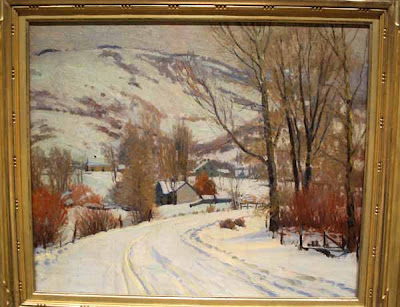"Art exists so that we may say the unsayable." LeConte Stewart
"Country Funeral"
Art is successful to me if it draws me in and lets my mind create a story to go with the piece. "Country Funeral" allows the viewer to imagine the whole town turning out to honor a member of the community. It is a quiet painting, and does indeed "say the unsayable."
LeConte Stewart Landscape
I had the opportunity to see the other half of the current LeConte Stewart art exhibit at the Church Museum of History and Art. It was a great experience to once again view the work of this outstanding Utah artist. I particularly enjoyed being able to see his brushwork up close, and to once again admire Stewart's mastery of lighting.
Detail of painting
I zoomed in on the above painting to photograph a detail of Stewart's brushwork, and to my surprise, found this to be a satisfying composition within his original piece of art. Perhaps that is the measure of a master--when a little piece of the painting could stand alone as its own work of art.
This exhibit has two parts: "LeConte Stewart: Depression Era Art" at the Utah Museum of Fine Art, and "LeConte Stewart: The Soul of Rural Utah" at the Church History Museum. These photographs come from "The Soul of Rural Utah" exhibition. Unlike its counterpart at the University of Utah, this exhibit focuses more on Stewart's landscapes.
Warmth captured in a Stewart landscape
Two things stood out for me in this show: Stewart's mastery of lighting, and his penchant for painting in the same area again. The lighting was particularly fascinating in the multiple landscapes Stewart did of snow scenes.
Ogden Valley, Winter
Stewart said of painting in winter: "Winter is lovely to paint because you get lovely color harmony. You get lovely notes of color, complementary colors of lavenders and oranges and beautiful notes of the sky. See how different they are, and yet they are closely related. You've got a beautiful harmony of color relationships--the lavenders in the road. Every note of color has a relationship. Just the sequence is tied up in a beautiful harmony. You feel that way about it." And when you look at painting after painting that Stewart did of winter scenes, you see the lyrical quality, you see the harmony. Stewart's paintings are visual music.
Detail of "Kaysville Winter" - note all the colors Stewart painted in the snow.
This particular painting, "Kaysville Winter" was one of my personal favorites in the exhibit. I loved the warmth in a snow scene and the late afternoon lighting on the side of the buildings. And I love the colors!
Kaysville Winter
LeConte Stewart painted often in the same areas. Several of the paintings in this exhibit have titles like "Autumn in Peterson," "Spring in Peterson," and "Winter in Peterson." By returning to the same locations again and again, Stewart was able to capture the color and light not only of different seasons, but also of different times of day.
Winter in Peterson
LeConte Stewart completed most of his paintings on location in one session. This is astounding, especially when you see the size and scope of some of the landscapes in this exhibit. He obviously had developed an incredible level of skill to capture a scene outdoors even as lights and colors fluctuated with each passing hour.
Autumn in Peterson
LeConte Stewart said: "Any art which survives must ring true to the hearts of humanity. It must be of the time and express the tempo of a people." I think Stewart was a master of capturing scenes that ring true in the "hearts of humanity," whether it be a quiet rural scene, or a Depression-era industrial view.
"Threshing Wheat"
This exhibit runs through January 15, 2012, so you only have one month left to experience the works of this fine Utah artist.
Interactive part of the art exhibit.
The exhibit includes interactive screens where you can create your own art masterpiece, or paint on a Stewart painting. There is also a video presentation about the artist. This is a great art experience for all ages.
"Artist's Umbrella" - 1923 - etching print, ink on paper
If you go: Admission to the Church Museum of History and Art is free. The hours are Monday through Friday, 9am to 9pm, and Saturday and Sunday from 10am to 7pm. It has shortened hours on some major holidays, and is closed on holidays like Easter Sunday and Christmas. The museum is located at 45 North West Temple in Salt Lake City. The exhibit continues through January 15, 2012.












Such an awesome exhibit. I've seen it twice and would love to go once more before it leaves. Thanks for sharing!
ReplyDelete